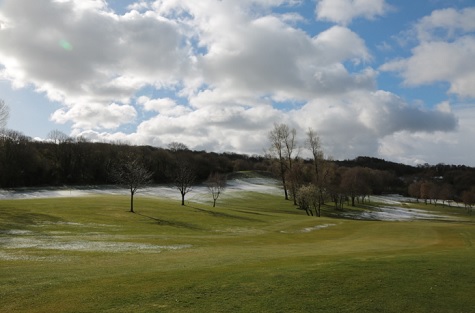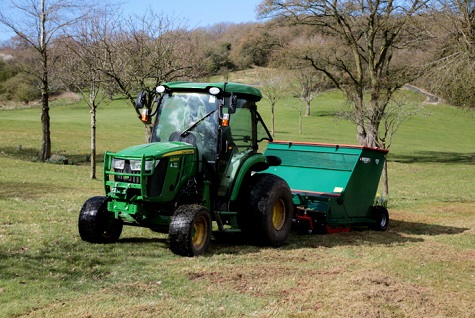A few weeks ago, I was invited to visit Wrekin GC, a Shropshire golf club steeped in history. Formed in 1905, it resides on the slopes in the shadow of the famous Wrekin Hill. A truly picturesque golf course surrounded by natural woodland, it benefits from spectacular and inspiring views across and beyond the North Shropshire plain.

I was there to witness the delivery of a Wessex STC 180 grass collector / scarifier that was being delivered by Matt Lewis from Charlies Groundcare & Machinery, Welshpool. The course manager Harry Jones had already trialled the machine last year and had persuaded the committee, with the help of local botanist John Handley, of the benefits this machine would bring to the club over time.

The course was remodelled in 1910 and the renowned golfers Harry Vardon and George Duncan were secured to play an exhibition match on the first day of opening. Today most of the greens are still the original clay, pushed up greens that were constructed all those years ago.
This par 66, 5599 yards long course has no hidden hazards. The difficulty comes from good golf course design and course management, with a premium for being in the right place to attack the tricky greens.
Course manager, Harry Jones, began his greenkeeping career as assistant greenkeeper at Shrewsbury Golf Club working under Dan Perry (head greenkeeper) & Chris Roberts (course consultant) in 2008. He fell straight in love with the job, gained NVQ level 2 & 3 within the first 2 years of being there then quite quickly had the chance to move to the Wrekin Golf Club in 2011.

He began working under the guidance of the club’s agronomist Chris Roberts and then in 2014 Harry took on the role of head greenkeeper. Harry has a team of four greenkeepers to help maintain the course - Gary Turner, Tony Cheese, Alex Brasenell and Liam Williams. Harry is very much hands on and all five are kept busy maintaining this parkland course.
Like most head greenkeepers, Harry has spent the last several years improving the playing surfaces, tees, greens and fairways.
Greens:- These are maintained at a winter height - 4.5mm and summer height - 3mm. Target speed for greens during the summer is around 10 on the stimp meter depending on conditions and they can run much quicker due to the undulations on the greens.

Tees:- Kept at a winter height - 16mm and summer height - 12mm
Fairways:- Winter height - 19mm and summer height - 16mm
The greens are worked on every day. Tees, approaches and fairways are cut generally three times a week during growing season. Aeration and dressing is carried out as much as possible during both winter and summer with a target of getting down at least 100 tonne of dressing across all putting surfaces
As for major works, the club have Installed new drainage systems into seven greens (one a year), with all this work being carried out in house by their staff. Seven new bunkers have been recently installed with the aim to construct a further three every winter.
Last winter the club invested a lot of money in improving pathways, relaying with tarmac and kerb edgings to improve trolley access around several busy areas of the course.
Apart from keeping the basics going, Harry is on a mission to improve the biodiversity and management of the course. He is keen to improve its aesthetics and increase the value of its natural assets, spending more time on woodland management and ecological management of the longer grass areas of the course - hence the investment in the Wessex STC 180.

By better management of these native rough areas, through scarifying every year, this will not only enhance the finer grass species to come through but will also save on man hours - vastly improving visual aspects of the golf course whilst encouraging more wildlife.
Alongside this work Harry is also overseeding with appropriate wildflower mixes to increase the visual aspects of certain parts of the course:-
- Behind the 9th green - Colour Splash & Aurora
- Front of 14th tee - Heavy Shade & Woodland along with Heavy Clay Mix
- 18th Tee area - Restore & Rich along with Cornfield Annuals
One of the biggest drivers towards this investment was the club investing in the expertise of John Handley, one of my old work colleagues at Maxwell Amenity. John is a well respected agronomist and ecologist and has worked with many greenkeepers. Living local, he was on hand to help Harry come up with a long term solution to improve the biodiversity of the course.
After several visits, meetings and the results of John’s ecology survey, Harry was in a better position to advocate the recommendations and get the club’s agreement to invest in the Wessex STC 180 he could then start improving the aesthetics, biodiversity and enrichment of wildlife and fauna at Wrekin GC.
I am pleased to say, I have received an account of John’s work and his thoughts on how Harry can continue to improve the course. Look out for next week’s edition of TurfPro where we’ll publish John’s report.